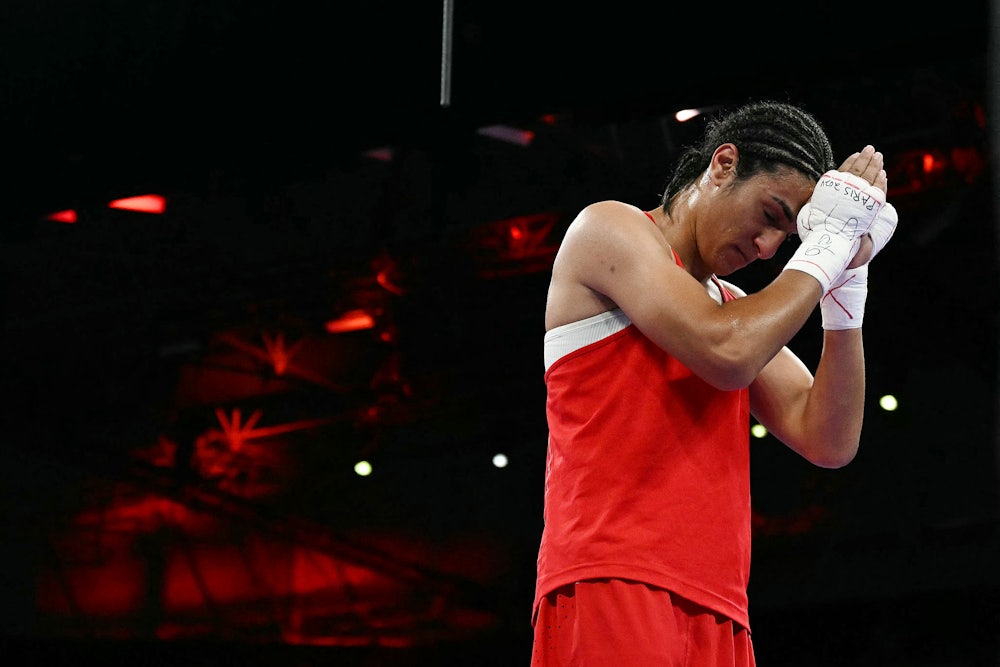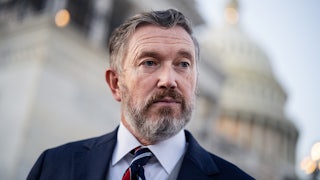On August 1, Algerian boxer Imane Khelif stepped into the Olympic ring in Paris. Forty-six seconds later, her opponent, Italy’s Angela Carini, was in tears, opting out of the match after taking multiple blows to the face. In the world of Olympic boxing, where competitors aim to render each other unconscious, this outcome wasn’t particularly unusual. What followed, however, was anything but ordinary.
Within minutes, a firestorm erupted on social media. Conservative pundits, politicians, and even celebrated authors decried Khelif as a “biological male” competing unfairly against women. The punch that ended the match was replayed millions of times, each view accompanied by increasingly vitriolic comments about the supposed death of women’s sports.
There was just one problem: Khelif isn’t transgender, and there’s no concrete evidence that she’s even intersex. She was assigned female at birth, has always identified as a woman, and has competed as one her entire career. The controversy surrounding her was built on a house of cards—unverified claims, misrepresented facts, and outright fabrications.
This manufactured outrage over Khelif’s gender identity isn’t just a story about one boxer or one Olympic match. It’s a stark illustration of how quickly misinformation can spread in our hyperconnected world, and how readily certain groups will weaponize that misinformation to further their own agendas. More disturbingly, it reveals the broader implications of unchecked transphobia—not just for trans individuals but for anyone who doesn’t conform to narrow, traditional ideas of gender expression.
Khelif is an Algerian boxer who has competed in women’s boxing for years. She participated in the 2020 Tokyo Olympics, where she was eliminated in the quarterfinals. Khelif has experienced both victories and defeats throughout her career, including a loss to Amy Broadhurst in the 2022 World Boxing Championships.
Despite rampant claims on social media and in some news outlets, there is no evidence that Khelif is transgender or that she has XY chromosomes. These assertions stem primarily from her disqualification from the 2023 world championships by the International Boxing Association, or IBA, an organization suspended by the International Olympic Committee due to governance problems and corruption issues.
The IBA, led by Russian president Umar Kremlev, claimed that DNA tests showed Khelif had XY chromosomes. However, the IBA never released details of the testing method or results, citing privacy concerns.
The IOC, which oversees the Olympics, has cleared Khelif to compete in the women’s category. IOC spokesperson Mark Adams emphasized, “Everyone competing in the women’s category is complying with the competition eligibility rules. They are women in their passports, and it is stated that is the case.”
Even Khelif’s opponent in the controversial Olympic match, Angela Carini, has not questioned Khelif’s gender. Carini clarified that her emotional reaction was due to her Olympic dreams being dashed, not any issue with Khelif’s eligibility.
The controversy unfolded with alarming speed and intensity, revealing the mechanics of how misinformation spreads in the digital age. Within hours of the match, social media users began sharing video clips, many accompanied by unfounded claims about Khelif’s gender identity. High-profile figures quickly amplified these unverified claims. J.K. Rowling posted that she saw “a male punching a female in the name of sport.” Elon Musk also weighed in, further spreading the misinformation to his massive follower base.
Conservative media outlets seized on the story, often presenting speculation as fact. Fox News hosts referred to Khelif as “a guy” and a “so-called person.” Laura Ingraham devoted 11 minutes of her show to the fight, linking it to the “fanaticism of politicians like Kamala Harris.”
Politicians then jumped on the bandwagon, using the controversy to score political points. Former President Donald Trump posted on Truth Social, “I WILL KEEP MEN OUT OF WOMEN’S SPORTS!” Several other Republican politicians made similar statements, despite the lack of evidence supporting their claims.
This controversy didn’t emerge in a vacuum. It’s part of a long-standing pattern of sensationalized media coverage surrounding gender-nonconforming athletes. From South African distance runner Caster Semenya to Indian sprinter Dutee Chand, we’ve seen how quickly questions about an athlete’s gender can overshadow their accomplishments.
Throughout the history of organized athletics, there have been attempts to categorize athletes based on gender. These efforts, often framed as ensuring “fairness,” have frequently resulted in invasive, humiliating, and scientifically dubious practices. From the nude parades of the 1960s to chromosome testing in the 1980s, these methods have consistently failed to capture the complexity of human biology and gender identity.
The case of Semenya provides a stark example of how these issues can play out on the global stage. Semenya has been subjected to intense scrutiny and regulation due to her naturally high testosterone levels. The media coverage of Semenya’s case often primed readers to question the fairness of her victories, with headlines like “Gender Test After a Gold-Medal Finish” appearing immediately after her performances.
This focus on “genetic advantages” in women’s sports is particularly telling when we consider the broader landscape of athletic competition. Many celebrated male athletes, from Michael Phelps with his unusually long arms and low lactic acid production to Usain Bolt with his exceptional fast-twitch muscle fibers, are praised for their genetic gifts. Yet when women athletes display exceptional abilities, there’s often a rush to question whether they should be allowed to compete at all.
The selective outrage over supposed genetic advantages in women’s sports reveals a deeper issue: the policing of women’s bodies and the enforcement of narrow definitions of femininity. This policing disproportionately affects women of color and those from the global south, as seen in the cases of Semenya, Chand, and now Khelif.
The manufactured controversy surrounding Khelif reveals far more than just misplaced concerns about fairness in women’s sports. It exposes a deeper, more insidious agenda that uses the guise of “protecting women” to reinforce traditional gender roles, control women’s bodies, and provide convenient scapegoats for those pushing a regressive social agenda.
At its core, this outrage is about maintaining and reinforcing a rigid gender binary. The vehement reaction to Khelif’s victory isn’t really about her performance or her right to compete. It’s about policing the boundaries of what it means to be a woman. By questioning Khelif’s gender based on her appearance and athletic prowess, these critics are essentially saying that there’s only one way to be a woman—and it doesn’t include being too strong, too fast, or too successful in traditionally male-dominated arenas.
This policing of gender norms extends far beyond the realm of elite sports. We’ve seen similar patterns in debates over bathroom access, where laws ostensibly aimed at transgender individuals have resulted in increased harassment of cisgender women who don’t conform to traditional standards of femininity.
Moreover, the focus on supposed threats to women’s sports serves as a convenient distraction from real issues affecting women athletes. While pundits and politicians rage about the hypothetical dominance of trans athletes, they remain silent on issues like unequal pay, lack of media coverage, and inadequate funding for women’s sports programs.
The manufactured controversy surrounding Khelif has real, tangible consequences that extend far beyond the boxing ring. The unchecked spread of transphobic rhetoric and policies has wide-ranging impacts on individuals, communities, and society as a whole.
First and foremost, we must consider the personal toll on the athletes at the center of these controversies. Khelif, like Semenya before her, finds her identity, her accomplishments, and her very humanity questioned on a global stage. The psychological impact of such scrutiny is immense. Athletes who have trained their entire lives suddenly find themselves the subject of invasive speculation about their bodies and identities.
But the consequences extend beyond these high-profile cases. The rhetoric used against Khelif and others creates a chilling effect for all gender-nonconforming individuals in sports. Young athletes who don’t fit neatly into traditional gender categories may be discouraged from pursuing their passions, fearing the kind of public scrutiny and harassment they’ve seen others endure.
The impact isn’t limited to sports. The same arguments used to exclude trans and intersex athletes from competition are being weaponized to deny trans individuals access to health care, education, and other basic rights. We’ve seen a surge in legislation aimed at restricting trans rights, often using the same flawed arguments about “biological advantage” that we see in sports debates.
Meanwhile, the rapid spread of misinformation surrounding Khelif’s case underscores the crucial role that media plays in shaping public perception and discourse. It also highlights the urgent need for both media literacy and responsible journalism in our increasingly complex information landscape.
Media outlets must recognize their power and responsibility in these situations. The way a story is framed, the language used, and the voices amplified can significantly impact public understanding and opinion. Responsible journalism requires more than just reporting what people are saying. It demands rigorous fact-checking, providing proper context, and actively countering misinformation.
But media responsibility is only part of the equation. In our current information ecosystem, where anyone with a social media account can become a publisher, critical thinking and media literacy are more important than ever. Readers and viewers need to approach news with a skeptical eye, especially when it comes to emotionally charged issues like gender in sports.
As we grapple with the fallout from the Khelif controversy and similar cases, it’s crucial to chart a path forward that promotes fairness, inclusivity, and respect for all athletes. This is not just about resolving a single incident but about reshaping our approach to gender in sports and society at large.
We need to move beyond simplistic, binary notions of gender in sports. Human biology is far more complex and diverse than the male/female dichotomy suggests. Sports governing bodies should work with scientists, ethicists, and athletes to develop nuanced, evidence-based policies that acknowledge this complexity.
Education plays a crucial role in moving forward. We need comprehensive programs that teach about gender diversity, not just for athletes and sports officials but for the general public, as well. This education should extend to media literacy, helping people critically evaluate the information they receive about gender and sports.
Last, we must remember that sports, at their best, are about celebrating human potential and bringing people together. The spirit of athletic competition should be one of mutual respect, fair play, and the joy of pushing human limits. By keeping this spirit in mind, we can work toward a future where all athletes, regardless of their gender identity or sex characteristics, can participate and excel without fear of discrimination or undue scrutiny.
Moving forward from the Khelif controversy and others like it requires a commitment to science, empathy, and human rights. It demands that we challenge our preconceptions, resist easy answers, and strive for a more inclusive vision of sports and society. While the path may be challenging, the reward—a sporting world that truly celebrates all forms of human excellence and diversity—is well worth the effort.






